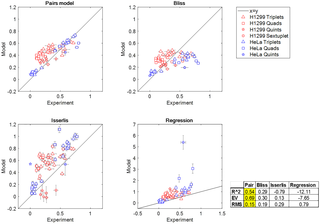PLOS Biology ( IF 9.8 ) Pub Date : 2017-10-26 , DOI: 10.1371/journal.pbio.2002518 Anat Zimmer , Avichai Tendler , Itay Katzir , Avi Mayo , Uri Alon

|
Cocktails of drugs can be more effective than single drugs, because they can potentially work at lower doses and avoid resistance. However, it is impossible to test all drug cocktails drawn from a large set of drugs because of the huge number of combinations. To overcome this combinatorial explosion problem, one can sample a relatively small number of combinations and use a model to predict the rest. Recently, Zimmer and Katzir et al. presented a model that accurately predicted the effects of cocktails at all doses based on measuring pairs of drugs. This model requires measuring each pair at several different doses and uses interpolation to reduce experimental noise. However, often, it is not possible to measure each pair at multiple doses (for example, in scarce patient-derived tumor material or in large screens). Here, we ask whether measurements at only a single dose can also predict high-order drug cocktails. To address this, we present a fully factorial experimental dataset on all drug cocktails built of 6 chemotherapy drugs on 2 cancer cell lines. We develop a formula that uses only pair measurements at a single dose to predict much of the variation up to 6-drug cocktails in the present data, outperforming commonly used Bliss independence and regression approaches. This model, called the pairs model, is an extension of the Bliss independence model to pairs: For M drugs, it equals the product of all pair effects to the power 1/(M−1). The pairs model also shows good agreement with previously published data on antibiotic triplets and quadruplets. The present model can only predict combinations at the same doses in which the pairs were measured and is not able to predict effects at other doses. This study indicates that pair-based approaches might be able to usefully predict and prioritize high-order combinations, even in large screens or when material for testing is limited.
中文翻译:

当测量次数有限时,预测药物鸡尾酒效应
药物鸡尾酒可能比单一药物更有效,因为它们可以以较低的剂量发挥作用并避免耐药性。但是,由于存在大量的组合,因此不可能测试从大量药物中提取的所有药物混合物。为了克服这种组合爆炸问题,可以对相对少量的组合进行采样,并使用模型来预测其余的组合。最近,Zimmer和Katzir等人。提出了一个模型,该模型可以基于对药物的测量准确预测所有剂量下鸡尾酒的效果。该模型要求以几种不同的剂量测量每一对,并使用插值法来减少实验噪声。但是,通常不可能以多剂量(例如,在患者来源的稀有肿瘤材料中或大屏幕中)测量每一对。这里,我们问仅一次剂量的测量是否也可以预测高阶药物混合物。为了解决这个问题,我们在2种癌细胞系上用6种化学疗法药物构建的所有药物混合物中,提供了完全析因实验数据集。我们开发了一种公式,该公式仅使用单次剂量的成对测量来预测当前数据中最多6种药物混合物的大部分变化,优于常用的Bliss独立性和回归方法。该模型称为结对模型,是对Bliss独立性模型进行结对的扩展:对于M种药物,它等于所有结对效应的乘积乘以1 /(M-1)。对模型也显示出与先前发表的有关抗生素三联体和四联体的数据的良好一致性。本模型只能预测在测量剂量对的相同剂量下的组合,而不能预测其他剂量下的效果。这项研究表明,即使在大屏幕或测试材料有限的情况下,基于配对的方法也可能能够有效预测并确定高阶组合的优先级。


























 京公网安备 11010802027423号
京公网安备 11010802027423号